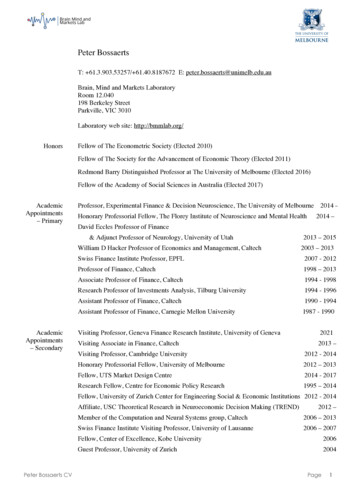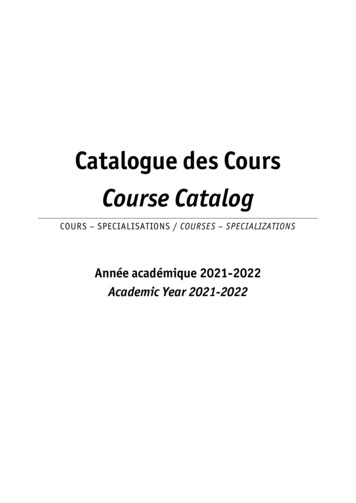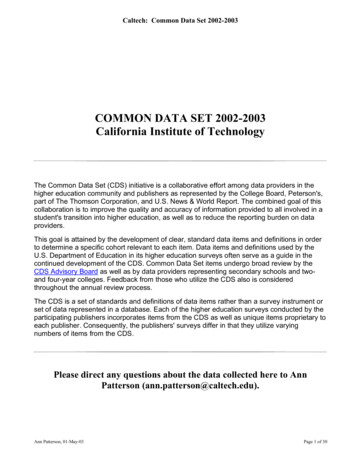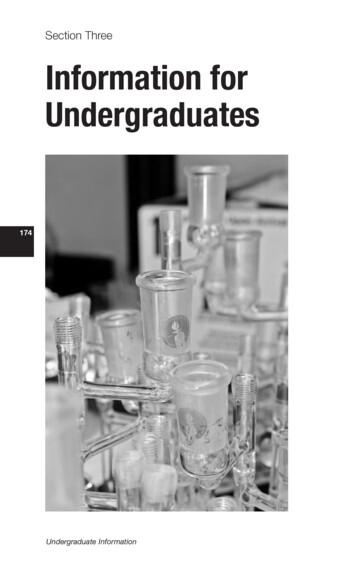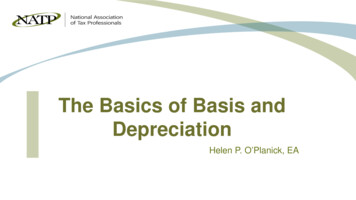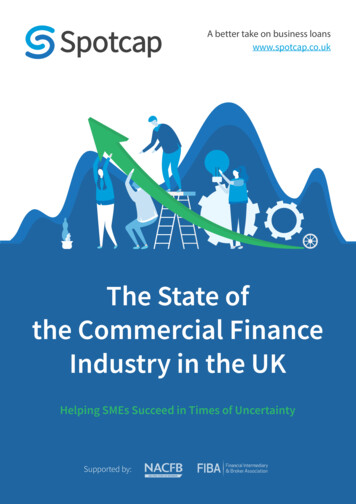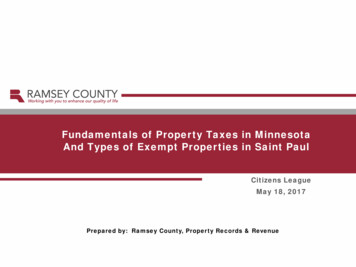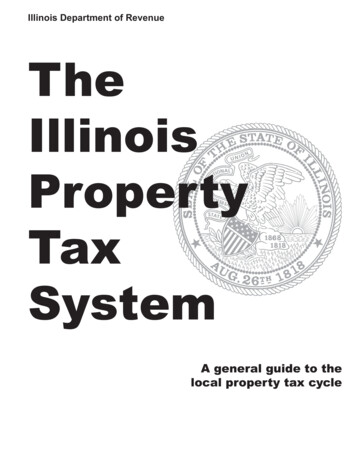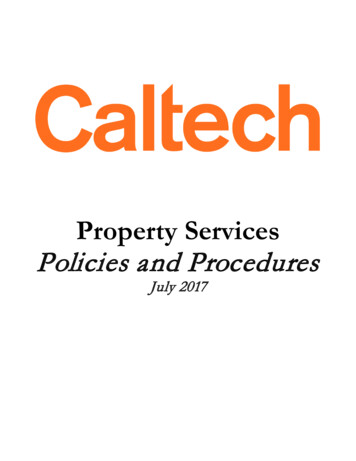
Transcription
Property ServicesPolicies and ProceduresJuly 2017
IntroductionChapter 1: IntroductionObjectives and OverviewThe Capital Equipment CycleDefinitionsAcronyms1.11.31.41.8Chapter 2: Global ConceptsManaging Capital EquipmentRoles and ResponsibilitiesInternal and External Accounting Audits2.12.52.12Chapter 3: AcquisitionPurchasingSubcontractor ControlDonations to CaltechProperty Loaned, Transferred, or Furnished to CaltechFabricationsReceiving PropertyIdentification: Tagging and Recording Property3.13.33.53.83.123.163.19Chapter 4: Records, Reports, and InventoryRecord KeepingRequired Property ReportsPhysical Inventory07/20174.14.34.6TOC
Chapter 5: UseMovementUtilizationMaintenanceStorageProperty Loaned by Caltech to an Outside Organization5.15.35.45.55.6Chapter 6: DisposalDisposition of AssetsDisposal Methods and When to Use ThemContract and Grant Closure6.16.66.13Chapter 7: Frequently Asked Questions (FAQs)Frequently Asked Questions (FAQs)7.1Chapter 8: AppendixSample Asset Information FormSample Property Loan (Borrower) FormSample Property Loan (Lender) Form07/20178.18.28.3TOC
Chapter 1: Introduction04/20151.0
Objectives and OverviewObjectivesAfter reading this manual, the reader should be able to understand: The basic concepts of the capital equipment cycle Global concepts in managing capital equipment Acquisition of capital equipment Record keeping, reporting, and inventory requirements Use of capital equipment on campus Disposal procedures for capital equipmentOverviewThis manual focuses on capital equipment and is intended as a general policy referencefor all California Institute of Technology (Caltech) personnel involved in the propertymanagement process. It frequently refers to other documents for more detailedprocedures applicable to specific personnel or topics.Property management of capital equipment is a key component in the efficientadministration of the professional educational and research missions of the Institute. Thebenefits include: Enabling Caltech to issue timely and accurate property reports to Federal and nonFederal research sponsors Enabling Caltech to recover indirect costs for equipment depreciation Allowing Caltech to have an accurate record of its investment in equipment Complying with external regulations and laws Meeting Division management needs04/20151.1
Facilitating the tracking and recording of maintenance and warranty information Enabling easy identification of available equipment Saving money by reducing waste, redundancy and equipment lossThe information in this manual contains eight chapters:1. Introduction – provides an overview of this manual.2. Global Concepts – addresses key concepts of property management as it relates tocapital equipment, roles and responsibilities of parties involved in the process, andinternal and external auditing.3. Acquisition – covers the purchasing, acquiring, receiving, and recording of capitalequipment. In addition, equipment loans to Caltech, transfers, and fabrications arediscussed.4. Records, Reports, and Inventory – deals with record keeping, required propertyreports, and inventory.5. Use – addresses movement, utilization, loans, maintenance, and storage of equipment.6. Disposal – covers the asset disposition process. In additions, it addresses contract andgrant closures (or closeouts).7. Frequently Asked Questions – includes questions that Property Services receivesregularly in addition to the answers to the questions.8. Appendix – includes forms and other supporting information not included within aspecific chapter.04/20151.2
The Capital Equipment CycleOverviewThe Capital Equipment Cycle covers the time span from when an asset is requested to theend of its useful life. The following diagram illustrates the general process flow of thatcycle.04/20151.3
DefinitionsOverviewThis subchapter provides some common definitions of terms used throughout thismanual.DefinitionsCapital Equipment“Capital Equipment” is actually an accounting term. For explanation purposes, we defineit as a moveable item which has a cost that meets or exceeds a specified cost threshold(such as a microscope or photocopier). Capital equipment, when compared with otherequipment, has more record keeping requirements and compliance requirementsassociated with it. See “Managing Capital Equipment” in the Global Concepts chapter ofthis manual for more information. At Caltech, capital equipment is defined as meetingthe following criteria:1. An acquisition cost of 5,000 or moreAcquisition cost includes the following: Invoice amount, sales tax, freight costs,installation costs, costs for the initial complement of supplies needed to place the assetinto service, accessory and auxiliary apparatus necessary to make it usable for thepurpose for which it was acquired; less trade or trade in discounts and/or educationalallowances.Acquisition cost excludes the following: Federal Excise tax, duty, insurance, maintenanceand warranty costs2. A useful life of more than one year.If the item will not have a useful life of more than one year, or the upgrade does notextend the useful life of the asset being upgraded by more than one year, it is consideredexpendable material, even if it costs more than 5,000.3. A stand-alone movable itemThe item is not permanently attached to or integrated into a building or structure.In addition, Caltech legally assumes certain responsibilities for sponsor-owned andsponsor funded property under its control.04/20151.4
NOTE: Sponsors may impose property management provisions i.e.tracking of sensitive items, imposing lower threshold for equipment, etc.that deviate from Caltech’s equipment capitalization policies. PropertyServices will work with OSR to make sure these requirements arecommunicated and are abided by.DispositionDisposition is the process of determining if capital equipment is an excess or an unusableasset. See “Disposition of Equipment” in the Disposal chapter of this manual for moreinformation.External AuditAn external audit is an examination of records by an organization other than Caltech. Forexample, the U.S. Government or a project sponsor would be considered an externalentity. See “Internal and External Accounting Audits” in the Global Concepts chapter ofthis manual for more information.ExcessA term that describes the lack of use or benefit a piece of equipment can give to a projector person. Any excess equipment, whether Caltech funded or sponsor funded, should beconsidered eligible for disposition. See “Disposition of Equipment” in the GlobalConcepts chapter of this manual for more information.FabricationA fabrication is a one-of-a-kind creation. Fabrications are created by assembling anumber of components (manufactured or custom made) to produce a piece of equipmentthat meets unique research specifications. Most fabrications are sponsor funded andtherefore have a number of compliance requirements related to acquiring and trackingequipment in an assembled fabrication. See “Fabrications” in the Acquisition chapter ofthis manual for more information.Oracle Asset ModuleA core component of efficient property management at Caltech is the Oracle Assetmodule. It is the Oracle application designed to electronically track property for capital orsponsor funded assets accountable to the Institute and to calculate depreciation forfinancial statement reporting and including in the Indirect Cost Rate proposal. It is the04/20151.5
official Institute record of property at Caltech. See “Managing Capital Equipment” in theGlobal Concepts chapter for more information.Government Furnished Material (GFM)Government Furnished Material (GFM) is property that is given to the Institute by theFederal Government and for which ownership remains with the Federal Government.GFM may be incorporated or attached to an end item to be delivered under a contract ormay be consumed or expended in the performance of an agreement. See “PropertyLoaned, transferred, or Furnished to Caltech” in the Acquisition chapter of this manualfor more information.Government Furnished Property (GFP)Government Furnished Property (GFP) belongs to the sponsor and is used pursuant toongoing agreement identified by the sponsor. Acquisition of GFP is initiated by the PI,assisted by the Division Representative, and processed through the Office of SponsoredResearch. See “Property Loaned, Transferred, or Furnished to Caltech” in theAcquisition chapter of this manual for more information.Internal AuditAn internal audit is an examination of records conducted by employees at Caltech. Theseaudits may be conducted by such groups as Property Services or Internal AuditDepartment. See “Internal and External Accounting Audits” in the Global Conceptschapter of this manual for more information.ObsoleteA term that means an item can no longer meet its intended purpose. For example, a mediastorage format that is no longer employed such as a 5¼ floppy disk drive. See“Disposition of Equipment” in the Disposal chapter of this manual for more information.POETACaltech’s accounting system uses an account code often referred to as POETA (Project /Organization / Expenditure Type / Task / Award). A POETA is actually a set of fivealpha-numeric characters, which combine to provide a detailed description of the type ofequipment acquired and its source of funding. Correct and accurate use of this accountingstructure ensures effective control, accurate classification and efficient reporting ofassets. See “Managing Capital Equipment” in the Global Concepts chapter of thismanual for more information.04/20151.6
Example of a POETA CodeCONT.03210.PropertyService.Materials and ionProperty ServiceExpenditure typeMaterial and SuppliesTask1AwardFIN.000320TATrade-in EquipmentThe acquisition of a piece of capital equipment from a vendor for some specified amountof money and an existing piece of Caltech-owned capital equipment is considered atrade-in. Trade-ins are actually a two-part process: a disposition and an acquisition . See“Identification: Tagging and Recording Property in the Acquisition chapter of thismanual for more information.04/20151.7
AcronymsThe following list includes acronyms used throughout this manual.APAccounts Payable (Oracle Specific Module)ASICAudit Services and Institute ComplianceCAPContractor Acquired PropertyCIPConstruction in ProgressDCAADefense Contract Audit Agency (DCAA),DODDepartment of DefenseEARExport Administration RegulationsETSEquipment Tracking SystemF&AFacilities and AdministrativeFAINFederal Award Identification NumberFARFederal Acquisition RegulationFDPFederal Demonstration PartnershipFMVFair Market ValueGFMGovernment Furnished MaterialGFPGovernment Furnished PropertyGLOracle General LedgerGPAGovernment Property AdministratorGSAGeneral Services AdministrationIDCIndirect CostIRSInternal Revenue ServicesITARInternational Traffic in Arms RegulationsLDDTLoss, Damage, Destruction, or Theft04/20151.8
MAMass Additions (Oracle Specific Module)NBVNet Book ValueNSNNational Stock NumberOAOracle Asset (Oracle Specific Module)OGMOracle Grant Management (Oracle Specific Module)ONROffice of Naval ResearchOSROffice of Sponsored ResearchPAAPost Award AdministrationPCSAProperty Control System AnalysisPIPrinciple InvestigatorPOPurchase orderPOETAProject / Organization / Expenditure Type / Task / AwardPRPurchase requisitionSOSSpeedy Ordering SystemWIPWork in ProcessYTDYear-to-date04/20151.9
Chapter 2: Global Concepts04/20152.0
Managing Capital EquipmentOverviewCaltech acquires capital equipment in a variety of ways, such as a purchase, a loan or adonation. The way capital equipment is acquired determines how it will be recorded andmanaged throughout its lifecycle.The Oracle Asset ModuleThe core component to efficient property management at Caltech is the Oracle Asset(OA) module, or also referred to as the ORACLE Fixed Asset System (FAS). It is theOracle application designed to electronically track property accountable to the Instituteand to calculate equipment depreciation for the facilities and administrative (F&A) costrate calculation and financial statements purposes. It is the official Institute record ofproperty at Caltech. Only Financial Services staff has access to OA. See “Roles andResponsibilities” in this chapter and “Identification: Tagging and Recording Property” inthe Acquisition chapter, or contact Property Services for more information.Caltech’s campus administration is, by its nature, decentralized. The OA module providesa central information resource where administrative officers can locate a piece ofequipment by searching for a tag number, serial number, custodian, purchase/requisitionnumber, etc. The module provides crucial information for the Institute relative to Caltech,Government and sponsor funded assets. It also assists with tracking loaned equipmentand other assets for which the Institute is accountable. These records are the basis forfiling required reports for sponsor and Government funded projects as well as financialand management reporting. Information from the OA module can also be used to identifyand report on the property purchasing trends of Caltech.Caltech legally assumes certain responsibilities for sponsor-owned and sponsor fundedproperty under its control. Caltech may therefore be liable in the event of loss orunreasonable use. Caltech’s responsibility commences from the moment the property isreceived and does not end until the Contracting Officer grants relief, the property(material) is used during completion of the contract, or title transfers to the Institute. It isimperative to capture the equipment information accurately in OA as soon as possible tomitigate potential loss and ensure regulatory compliance.Three Key Questions Regarding PropertyProperty control is a crucial component of property management and these questions helpus determine how to control property.1. How was the equipment acquired?04/20152.1
Purchase: Follow general Caltech internal policies described in this manual Donation: Refer to donation documentation for specific donor restrictions Loaned to Caltech: Refer to loan documentation for specific instructions Transferred from outside entity or sponsor: Refer to transfer documents or sponsoragreement for specific instructions2. Who funded the acquisition? Caltech funded: Follow general Caltech internal policies described in this manual Sponsor funded: Follow sponsor directions, as well as Caltech internal policiesdescribed in this manual. This also applies to either furnished, leased, rented, ortransferred (including inter-contract) equipment.3. Was the acquired equipment considered capital? Capital equipment: Follow general Caltech internal policies described in this manual Non-capital equipment: Follow general Caltech internal policies described in thismanual or as required by the loan or sponsor agreementManaging Property at CaltechThere are property management tasks that are common to managing all equipment. Thefollowing is a brief summary of those tasks. The chapters and/or subchapters referencedafter each item will provide more detail on related policies and procedures.When Equipment Arrives at CaltechCapital equipment should be properly received, including unpacking and inspectingequipment to insure that the proper equipment has been sent and is in good condition. See"Receiving Property" in the Global Concepts chapter of this manual.Incoming capital equipment should be promptly tagged with a Caltech Identification Tagand any other appropriate identifying markings, and then recorded into the OA module assoon as possible. See "Identification: Tagging and Recording Property” in theAcquisition chapter of this manual.04/20152.2
NOTE: The goal is to ensure that all capital or Government-ownedproperty is received, tagged and promptly recorded in OA module uponarrival on campus. Equipment is not insured for damage or theft by Caltech until theequipment is recorded in Oracle Fixed Assets. If equipment is received butnot tracked because PS is not notified, the end-user or the Division may beliable for replacing the damaged or stolen equipment.While at CaltechWhen equipment is moved its new location must be recorded into the OA module. It isvery important that Caltech properly track the location of capital equipment so thatdepreciation included in the IDC rate proposal is correctly calculated and allocated. It isalso critical since all equipment will be physically inventoried at least once every twoyears (in compliance with Federal regulations).If the equipment requires maintenance (for example, calibration for testing equipment) itshould be done in accordance with the manufacturer's recommendations.Caltech equipment, whether located on or off campus, should be used for work benefitingCaltech. No equipment purchased with Institute or sponsor funds should be used forpersonal use.When Equipment is no Longer NeededAn ongoing task in property management is assessing what equipment is excess andtaking steps to reuse or dispose of that property. See "Disposition of Assets" in theDisposal chapter of this manual. In addition, sponsor funded equipment must be handledin accordance with specific sponsor regulations or procedures.Federal Demonstration Partnership (FDP)Most of the Federal sponsored research grants performed at Caltech fall under the FederalDemonstration Partnership (FDP). FDP is an association of federal agencies, academicresearch institutions, and research policy organizations that work to a streamline theadministration of federal sponsored research projects. Government grants are either FDPor non-FDP grants. One major difference between a FDP and non-FDP Governmentgrant is that title immediately vests in Caltech for property acquired under a FDP award,but may or may not for a non-FDP award. Since title does not vest in the sponsor, Caltechassumes more of the risk and liability, but has fewer management and reportingrequirements. Caltech is not allowed to purchase real property (i.e. land or buildings)under a FDP grant.04/20152.3
This manual is written to ensure that Caltech meets the FDP requirements. However,non-FDP projects have additional administrative requirements that must also be met. Ifone is unsure whether his or her project falls under the FDP agreement, he or she shouldcontact the Office of Sponsored Research (OSR) or Property Services.04/20152.4
Roles and ResponsibilitiesOverviewProperty management is an important function at the Institute. Prudent business practiceshelp to protect the Institute’s multi-million dollar investment in capital equipment, meetGovernment and sponsor requirements, and support the indirect cost recovery associatedwith assets at Caltech. This subchapter describes how various groups at Caltech worktogether to ensure that efficient property management remains a high priority.Role of Property ServicesProperty Services has a critical role in developing and implementing campus propertymanagement policies in conjunction with Financial Services senior management.Property Services supports each Division in meeting administrative objectives.Specifically, it provides assistance in handling any property management and accountingissue, including a wide variety of property related issues that arise from the time ofacquisition through disposal. For areas involved in sponsored research, Property Servicesprovides assistance with equipment issues at the time of proposal development, projectperformance, and at the conclusion of projects or the retirement of equipment.In addition, Property Services can provide assistance or direction in the following areas:Acquisitions Researching equipment documentation Validating and verifying if purchases are expendable or capital Identifying and tagging equipmentRecords and Documentation Documentation of equipment transfers to or from other organizations Documenting and recording all capital equipment Documenting equipment transfers to other departments within Caltech Documenting equipment donated to the Institute04/20152.5
Transferring title to equipment Using Caltech’s Oracle Assets module Reconciling physical inventories of department equipment Reporting on property issues to Financial Services, sponsors, and donorsDisposal Assistance regarding disposal restrictions Documentation of dispositions for sponsor-owned equipment Documentation of disposition instructions for scrap or unusable equipmentSponsored Projects Reconciling equipment expenditures on sponsored projects at project closeout Monitoring capital projects for capital equipmentProperty Services is also responsible for corresponding with Government propertyofficers on property issues and developing and implementing any required correctiveaction plans related to property management.Information updates are disseminated by Property Services through internal classes,property forums, research forums and/or electronic mail. Individualized instruction isavailable upon request. Division Representatives may also contact Property Servicesdirectly to discuss matters specific to their areas.Compiles Metrics on Property ManagementProperty Services collects data from the Divisions and reviews it for completeness, theninputs and updates the OA module records. This information can be used to gauge howwell the property management process works and where improvements are needed.Property Services assists the Division, the Division Representative, and DepartmentManagement by meeting with them to ensure proper resources are available to create asmooth and accurate property management processes. Property Services may periodicallysend feedback via email or reports to Division Administrators and DepartmentManagement. This feedback may include areas where the Division or department is doingwell, as well as areas requiring improvement.04/20152.6
Self-AssessmentProperty Services is responsible for ensuring that a self-assessment is completed everytwo years and will use the self-assessment as an opportunity to review business processesassociated with all the facets of fixed assets management. Results of the self-assessmentwill be made available to ONR upon completion of the assessment includingmanagement review and to sponsors upon request. As a result of the self-assessment,improvements may be made to the property control system and procedures. Anysignificant deficiencies will be documented and corrected. If needed, contact PropertyServices for more information or see the Self Assessment Policy Document at located athttp://finance.caltech.edu/documents/377caltech s self assessment process document.pdfRole of Financial ServicesFinancial Services is responsible for ensuring that financial policies and practicesapplicable to the work of the Institute, including instruction and research, are carried outand that standards, policies and regulations are consistent with sponsor and donorexpenditure restrictions. Specific responsibilities include: Implementation of property management policies, processes, and personnelassignments within the department area(s), to enable the meeting of compliance anddepartment business needs. Emphasizing the importance of appropriate and compliant property managementwithin the Institute or business area.Role of Division ManagementCaltech is involved in a performing a significant amount of research. Institute property ismanagement has high visibility and may be subject to greater scrutiny and audits becausefunding for research is often sponsored by the Federal Government and other grantingagencies. Also, there are additional rules and regulations that must be followed if adepartment receives donated equipment. See "Donations to Caltech" in the Acquisitionchapter of this manual for information on how to handle donated equipment. NOTE: Accurate recording of all equipment, whether sponsor funded ornot, directly impacts indirect cost recovery and other reportingrequirements.To support more effective and compliant property management at Caltech, the Institutecontinues to improve campus-wide property management processes. Property Services04/20152.7
will make every effort to ensure that Divisions are made aware of any issues that willaffect their property management responsibilities.Division management should involve Property Services whenever contacted by anyinternal or external auditor regarding equipment. Property Services will work closelywith the Division and the auditing agency to ensure timely and adequate responses areprovided while mitigating any Institute risk.Tracking Incoming PropertyDivision Administrators should be listed on a purchase requisition so they can beinformed of any new capital equipment arriving in their area of responsibility. Thisallows the Division to supervise the request for inventory tags and operation of theirreceiving process. NOTE: The goal is to ensure that all capital and Government fundedproperty is received, tagged and promptly recorded in OA upon arrival oncampus.Data and MetricsDivisions provide Property Services with data and or information which PropertyServices uses to input and update the OA module records. This information can be usedto gauge how well the property management process works and where improvements areneeded. The Division Representative and Department Management meet with PropertyServices to ensure proper resources are available to create smooth and accurate propertymanagement processes. Division Representatives and Department Management canutilize feedbacks and reports received from Property Services via electronic mail toidentify areas where they are doing well as well as areas requiring improvement.Biggest Division ChallengesOne of the greatest property challenges a Division has is to help maintain, complete,current, and accurate equipment records while juggling a myriad of projects in the regularworkday.This challenge is best met when a Division is able to develop and communicate properprocedures and relevant policies to department personnel. Some stumbling blocks thatcan hinder timely entry of the OA module records are: Lack of communication between end user and Division Representative Lack of documentation04/20152.8
Transfer of equipment between departments or other research/educational institutions. High staff turnover Availability of time to perform property-related tasks Management support Time and priorities Time to attend training Need for increased involvement in property-related activities Need for increased communication Cooperation from users, custodians, Principal Investigators (PIs), etc. Inherited backlogsRole of Division RepresentativeAccountability for Caltech owned equipment, from acquisition to disposal, resides withthe Divisions. Accountability for equipment on Sponsored Projects resides with thePrincipal Investigator (PI) or PIs.Each Division should designate a responsible Representative (or Representatives) tofacilitate the property process. The role of the Division Representative is crucial for theDivision to accurately account for and control capital equipment. This individual willhelp ensure that capital equipment is accounted for consistently and records maintainedappropriately. In addition, they can make sure closets and storage areas are organized andexcess equipment disposed of as soon as it is no longer needed. Division Representativesaccomplish this by updating and maintaining copies of supporting documentation and bystaying in regular contact with people in their department who use the equipment.Divisions are responsible for: Promptly receiving new equipment. Notifying Property Services immediately when Government-owned equipment isreceived.04/20152.9
Notifying Property Services in a timely manner, preferably via the EquipmentTracking System (or an Asset Information Form) when equipment has been: DisposedTransferredLoanedBecome obsoleteBecome excess Assisting Property Services in performing equipment physical inventories. Reconciling equipment not found and equipment found to be not tagged duringphysical inventory (including providing support documentation). Using the correct expenditure type to identify title to equipment as Caltech,Government, or Other Owned. Assisting in internal and external audits as required.The Division Representative may attend the following in order to assist them inunderstanding their role: Introductory Division Representative property process training classes and labssponsored by Property Services Property forums conducted by Property Services on an “as needed” basis NOTE: Property forums should always be attended. They provideimportant updates and a venue for Division Representatives to give inputon the property process.Additional Skills for Division RepresentativesSome Division Representatives may require additional skills because of the addedcomplexity of research or sponsor requirements for assets within their area. They need toknow about external screening, cost sharing and fabrication requirements, among othertopics. Additional training is available through Property Services and certification is alsoavailable from a national association for those Division Representatives seeking a higherlevel of expertise.Benefits of Having a Division Representative04/20152.10
Caltech must track each piece of capital equipment throughout its lifecycle— from thetime it arrives at the Institute until it leaves. Division Representatives and PropertyServices are partners in tracking and managing property. This role is becomingincreasingly important in ensuring that capital equipment is acquired and utilized in themost efficient manner possible.The Institute as a whole benefits tremendously from efficient management of thethousands of pieces of equipment whose total value is quite significant.04/20152.11
Internal and External Accounting AuditsOverviewAll property that Caltech owns
It is the Oracle application designed to electronically track property for capital or sponsor funded assets accountable to the Institute and to calculate depreciation for financial statement reporting and including in the Indirect Cost Rate proposal. It is the 04/2015 1.6 official Institute record of property at Caltech.
